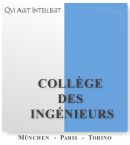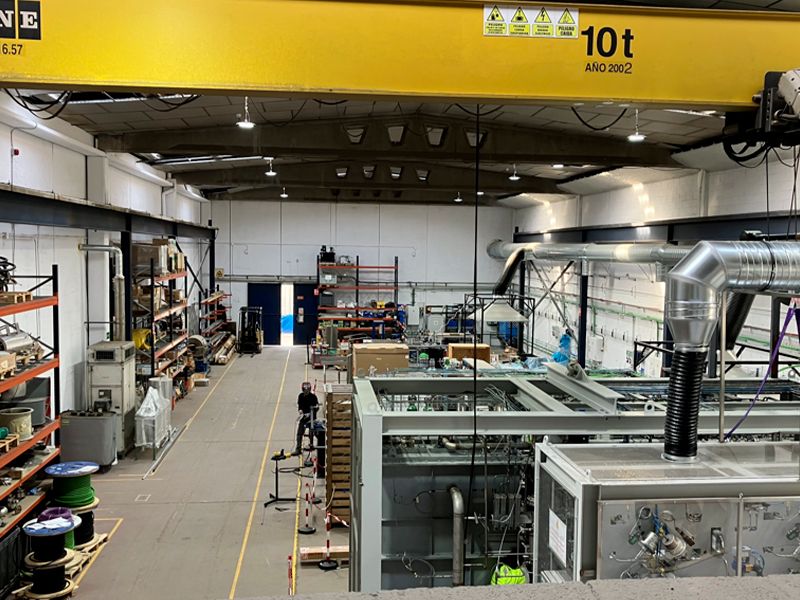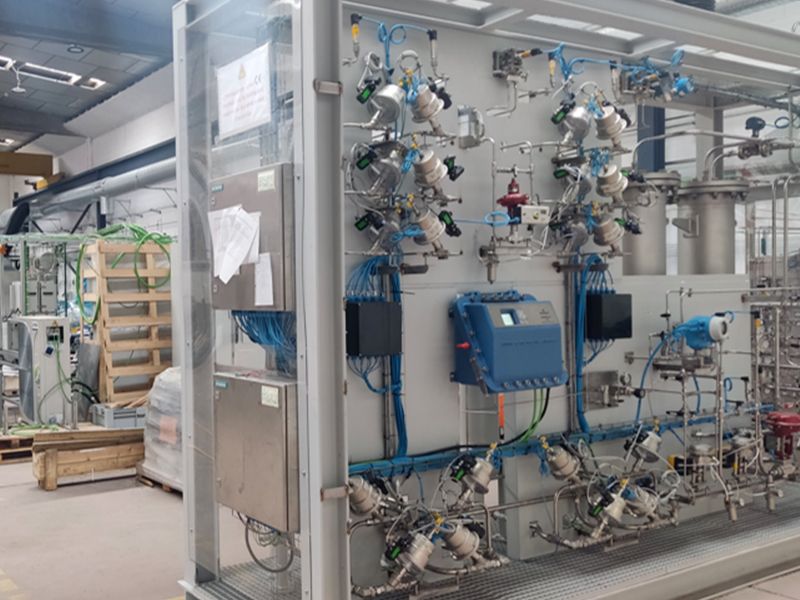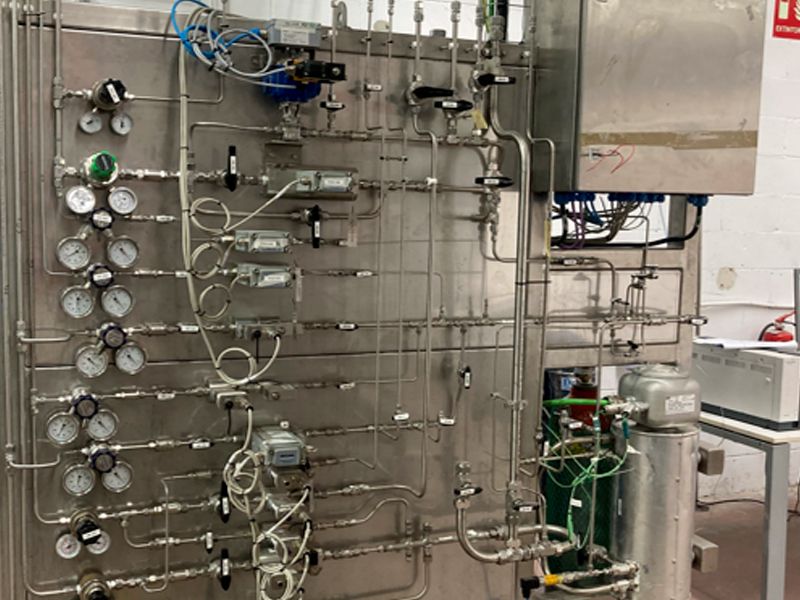TEST TYPES
- Techno-economic and life cycle assessment.
- Policy assessment and regulation compliance.
- Business development.
- Create new partnership and access new solutions.
- Professional mentorship.
FURTHER SERVICES
-
Simulation platform supporting product innovation from concept to market, including performance modelling and cost optimisation.
SHOWCASE #1
Solid Oxide Electrolysis Cell (SOEC)
Solid Oxide Electrolysis Cell (SOEC)
Showcase #1 is an opportunity to test lines #1, #8, and #9, enabling the creation of a case study that can serve as a reference for startups and SMEs looking to leverage these services. By validating different aspects of high-temperature electrolysis, this initiative will provide key insights into the technical feasibility, design optimization, and environmental impact of this cutting-edge hydrogen production technology.
H2B2 is developing a high-temperature electrolysis stack [DMA1] designed to produce low-carbon hydrogen more efficiently. This innovative system leverages Solid Oxide Electrolysis Cells (SOECs), which operate at 800-900°C, significantly reducing the electrical energy required for hydrogen production compared to conventional electrolysis technologies.
A key innovation in this stack is the integration of 3D printing technology in the manufacturing process. Using stereolithography (SLA), H2B2, in collaboration with IREC, has developed corrugated electrolyte membranes, enhancing hydrogen output and mechanical stability while maintaining a compact stack design. This breakthrough optimizes performance, simplifies component integration, and improves the system’s overall efficiency and cost-effectiveness.
Cells and stacks characteristics
-
Cell size
112 x 77 mm2
-
Stack size
120 x 80 x X mm3 (X depends on the number of cells)
-
Electrolyte thickness
250 μm
-
Electrolyte material
3YSZ or 8YSZ
-
Electrode materials
Fuel electrode: Ni-YSZ / Oxygen electrode: LSM-YSZ
Cells and stacks operating conditions
-
Operating temperature
850-900 ºC
-
Operating pressure
Atmospheric pressure
-
Fuel composition
From 95/5 to 50/50 H2O/H2
-
Air composition
79/21 N2/O2
-
Fuel flow
From 3 to 20 NmL/min/cm2/cell
-
Air flow
From 0.5 to 3 times the fuel flow
-
Current density
At 900 ºC, 0.45 A/cm2 at 1.3 V
Test Line #9 with CDI Collège des Ingénieurs will provide an integrated benchmarking and evaluation framework, including a Life Cycle Assessment, techno-economic analysis, and comparative performance review. These activities will measure the environmental footprint, cost competitiveness, and market readiness of the technology-crucial for future adoption and commercialization.
SHOWCASE #3
Steam Methane Reformer (e-SMR)
Showcase #3 of the H2SHIFT project focuses on an electrified Steam Methane Reformer (e-SMR) designed for the production of low-carbon hydrogen from biogas and biomethane. Led by Politecnico di Milano (POLIMI), this showcase puts into practice advanced concepts of electrification and system intensification for hydrogen production, involving Test Line 3 led by SNAM and Test Line 9 led by CDI.
This technology is a compact, high-efficiency reactor developed by the Energy Department’s Group LCCP at POLIMI and composed of resistive heating elements embedded in porous copper-based materials, packed with highly active catalytic pellets. The combination of the catalyst and an efficient heat transfer allows to thermal efficiency above 90% in conditions relevant for biogas reforming. The system is designed to be pseudo-isothermal and compact, operating at 800°C with a power density above 5 MW/m³.
Compared to traditional SMR systems, this electrified reforming technology reduces direct CO₂ emissions (approx. 7 kgCO₂/kgH₂ vs. 11–13 gCO₂/gH₂) and using biogas as a feedstock lowers the overall carbon footprint, making the hydrogen production process more sustainable. The power demand of this system is about 17 kWh/kg H2 – a value remarkably lower than 44-55 kWh/kg of state of the art electrolyzers.
Alongside the technical validation, Test Line #9 will contribute additional services:
- A techno-economic analysis to calculate the Levelized Cost of Hydrogen (LCOH).
- A regulatory compliance check to determine feasibility for market deployment.
- An optional Life Cycle Assessment to quantify the environmental footprint of bio-hydrogen from e-SMR.
SHOWCASE #4
Integrating Reforming and Purification for Hydrogen Production
Showcase #4 of the H2SHIFT project focuses on testing and validating the Viver Cleantech methanol reformer, with support from Técnicas Reunidas (TR). The goal is to demonstrate the integration of reforming and purification technologies in a flexible and robust testing environment, moving toward the production of high-purity hydrogen from methanol/water feedstocks.
The methanol reformer, developed by Viver Cleantech, will be connected to Técnicas Reunidas’s advanced Pressure Swing Adsorption (PSA) skid, designed to purify hydrogen by removing CO, CO₂, H₂O, CH₄ and other impurities at pressures from 8 to 20 barg. PSA off-gases will be fed back into the reformer as a combustion fuel, optimizing energy use while reducing emissions.
TR’s testing platform provides a fully automated, intelligent control system, equipped with comprehensive instrumentation, gas analyzers (GC, H₂O, CO, CO₂, CH₄), and data acquisition tools. The site will be adapted to connect and integrate all necessary interfaces from the reformer: fuel supply, syngas outlet, venting, condensate management, and control system connections.
In this setup, both the reforming and purification stages can be tested in a controlled environment. Flexible blending panels allow simulation of various gas compositions for detailed performance testing, while the reformer and PSA are integrated to condition and recycle off-gas streams. Safety, efficiency, and high configurability define this industrial-grade setup.
Test Line #9 thanks to CDI will be involved in performing:
- Techno-economic assessment of the hydrogen production process.
- Regulatory compliance analysis.
- Optional Life Cycle Assessment (LCA) to evaluate the environmental footprint of the integrated process.
SHOWCASE #5
HyAccelerator
Showcase #5 within the H2SHIFT project is dedicated to supporting the first industrial deployment design (FID-d) of a startup or SME’s hydrogen-related innovation. This showcase is directly connected with Snam’s HyAccelerator, a leading corporate accelerator for hydrogen technologies, and is part of the project’s efforts to validate the Open Innovation Test Beds (OITB) service ecosystem.
The selected beneficiary -chosen among the finalists of the HyAccelerator 2025 program- will receive a wide range of non-technical support from CDI through Test Line #9, focused on business development, mentoring, and go-to-market strategy.
Services include:
- Perimeter definition for a tailored use case
- Monitoring of results and project milestones (PMO)
- Market trend analysis, benchmarking, and deep-dives
- Development of a roadmap for industrial deployment
- Strategic mentorship and ecosystem navigation
- Communication and visibility support
This showcase represents a strategic bridge between acceleration and real industrial validation. It offers an invaluable opportunity for a startup or SME to benefit from high-level expertise, market insight, and operational support while preparing their solution for scaling.
Through this collaboration, H2SHIFT not only validates its services but also empowers innovative hydrogen ventures to reach the next level of commercial and industrial readiness.




